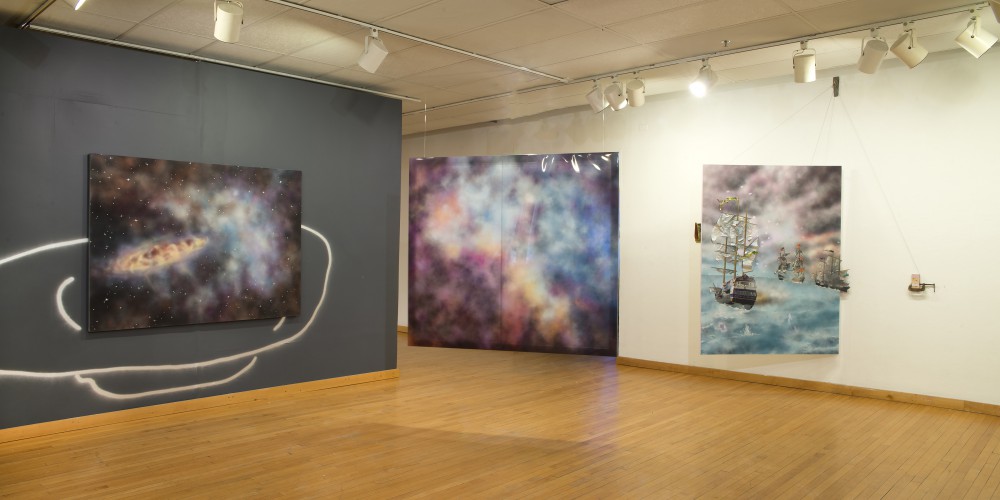
Wind Challenge Family Ties
In 1978, Larry Spaid was featured in one of Fleisher’s very first Wind Challenge exhibitions. Now, 38 years later, his son Raphael Fenton-Spaid follows in his footsteps – even showing in the exact same space in the gallery as his father – in Wind Challenge 3, on view through May 13, 2016. We checked in with Raphael for a brief Q+A about how his work differs from that of his parents (his mom is accomplished contemporary artist Susan Fenton) and how being a Challenge artist has affected him.
Tell us a little bit about your work, specifically the pieces you have in Wind Challenge 3.
For this show, which I have loosely entitled $pling, I wanted to focus on my interest in light and reflection as both a material and a painted idea. Painters like Casper David Friedrich and J.M.W. Turner use light to reinforce, establish, or even abstract a specific narrative. Often the light is heightened to an almost artificial level, creating a new layer of narrative to what are often landscapes with few if any figures. The light becomes the figure to follow through the landscape.
I’ve been working with landscape for a few years now, mostly through mixed media, and in playing with how the object of a painting can be presented in a given space. The relationship of the particular image within the painting and how it is hung, or presented becomes important. For the painting Everything I Have Learned, or the “ship painting” as I tend to call it, I used cables and pulleys to help the painting float off the wall, like a sail or a flag on a ship. The angle can be altered depending on which cables are tightened, and the painting sways when air moves through the space. The stability in how it is hung is quite precarious, which feels appropriate as I am referencing a very specific, and almost cliché trope in male Western painting history.

That piece was a lot of fun for me to make, and I couldn’t help but think about playing with toy boats in a tub. I think battleship paintings are something I’ve been making in one way or another since I can remember. It felt appropriate to include the small mixed-media piece next to and slightly behind the ship painting as I made that when I was five years old. For me it shares a lot of basic formal characteristics with the ship painting, and its color and composition feel like an almost abstracted study for the ship painting. There are also aspects of “play” with material that I feel I was doing as a child and continue to explore through collage and paint today.
Finally, I wanted this show to focus on my return to painting in comparison to recent works that have more blatant uses of collage and 3D elements. There is collage in a number of the works, but I wanted the use of collage and alternative materials like balloons and wrapping paper to blend into the pictorial illusion that the painted image creates. I want the paintings to create a pleasingly disorienting sensation in the viewer. The heavy use of spray paint and the lack of hard edge creates an almost moving image that I’ve enjoyed playing with in the past but really wanted to focus and hone in on in this body of work.
What is it like to be part of Wind Challenge, given that your father was one of the very first Challenge artists?
It is a real pleasure and honor to be part of the Wind Challenge, period, but I can’t help but be moved and slightly humored by the fact that my dad showed in the same gallery space 38 years ago. My dad has been a huge influence on my life as both an artist and a person.

Above: Larry and Raphael in earlier, more mustachioed times.
The small work entitled Mouse Trap that I mentioned earlier I made in our basement workshop that was effectively my dad’s “man cave” of sorts. I’m sure the nails and scraps of wood I used in the piece were discarded bits he used for rehabbing our house or other projects. He has always been handy, and from a young age I took an interest in helping him and later worked as a carpenter. A lot of those experiences are in my work and a part of the process. I enjoy working with my hands, getting messy, and while the work isn’t always messy, the process in making it is physical. It’s important I feel and handle the material through the making. Spray paint is a funny thing in that it is harder to control, but it’s use is highly physical and almost performative.
While my work differs greatly on the surface from both my parents’ work I think there are formal and compositional consistencies and considerations that are quite similar.
What impact did Wind Challenge have on your father’s career and how do you think it might affect yours?
I think the show helped place him in the Philadelphia Art community and played an important role in his receiving tenure at Tyler School of Art very soon after the show. While he is the first to admit it is difficult to pinpoint specifics 38 years later, he’s had nothing but love and respect for Fleisher and his experiences there.

This is really my first solo show since Me Painting Show, my MFA thesis exhibition at Temple Contemporary in spring 2014. In showing new and very recent work at Fleisher, the biggest impact so far has been one of self-reflection and satisfaction. I feel the work has changed and grown in ways that continue to keep me enthused and focused in the studio. It’s been rewarding to hear others comment on that as well. I think like anyone would feel, I hope the work at Fleisher helps expand my audience, and that that audience finds it engaging.
The Wind Challenge Exhibition Series is made possible with thanks to generous support from the Wind Foundation, the National Endowment for the Arts, and through Fleisher members.

 Donate
Donate
To get updates on events, exhibitions & class information:
"*" indicates required fields